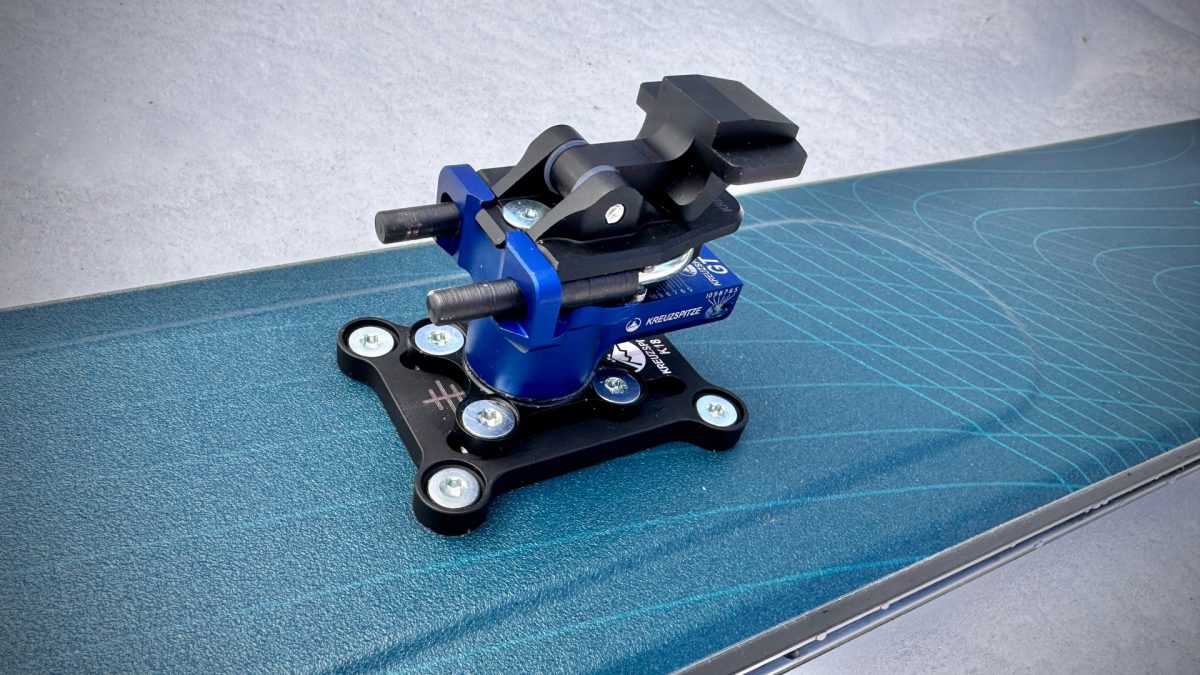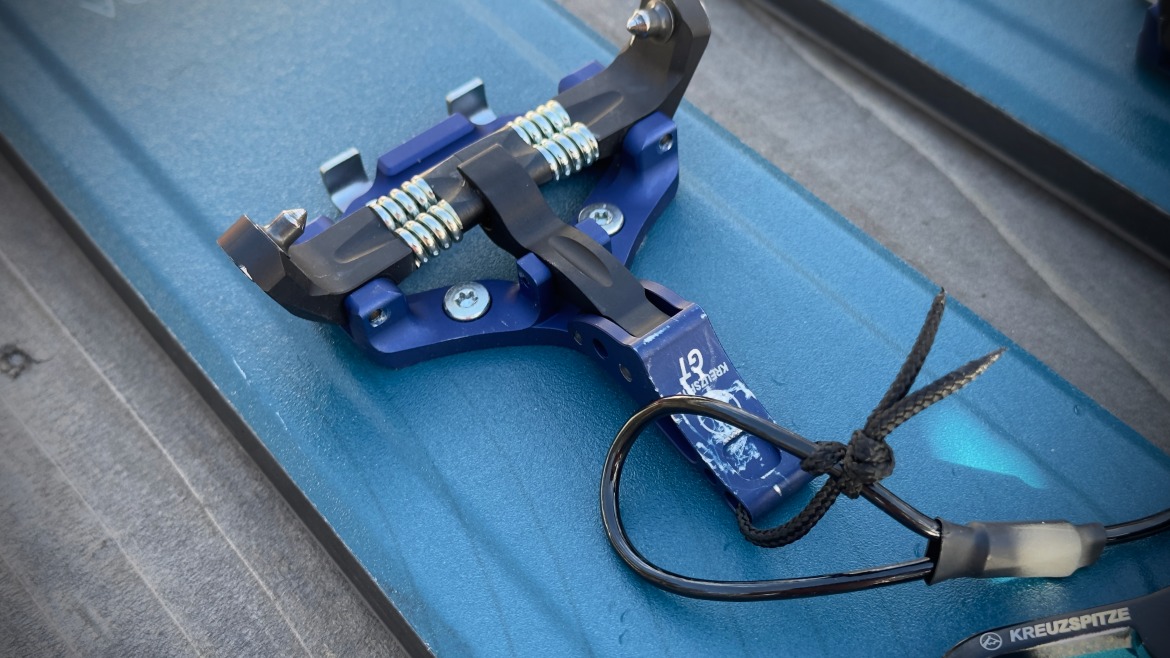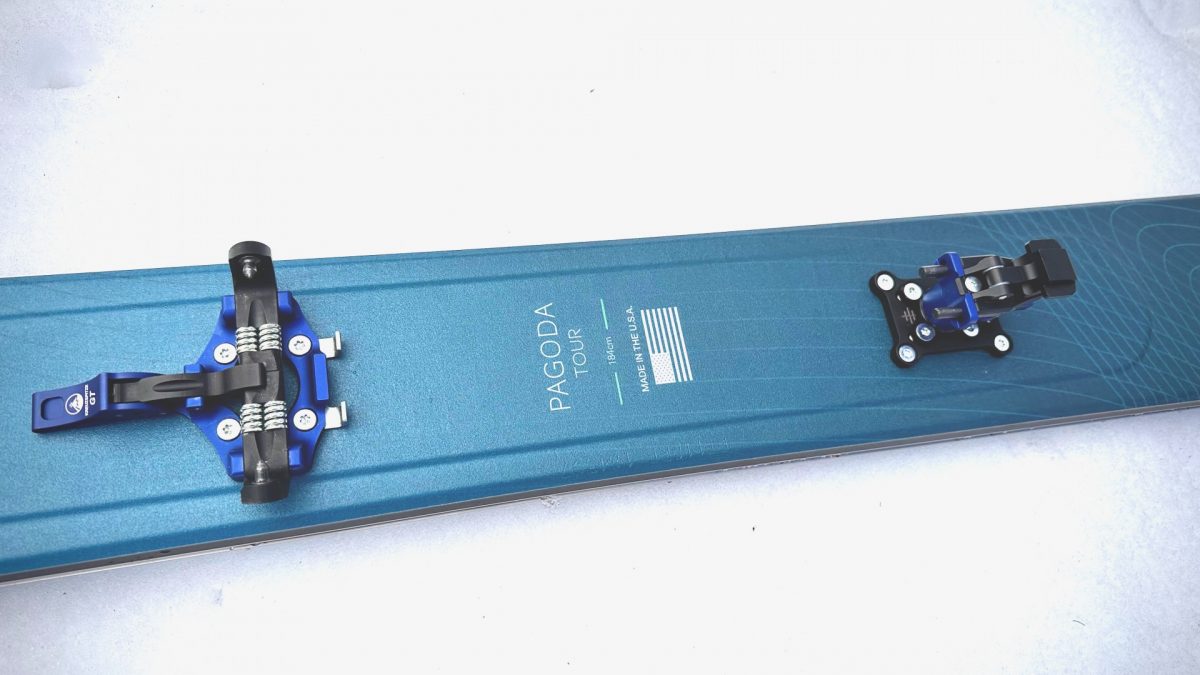
The Kreuzspitze GT 2.0 offers a lightweight tech binding weighing 190g without the adjustment plate.
The Kreuzspitze GT 2.0 binding comes in a weight-wise package (sub 200g for the basic unit) and adjustable release values. Click in and go.
Kreuzspitze GT 2.0, say it ten times fast. Or, pay for it once, at $495.95, and you have an Italian-crafted binding weighing 190g without the adjustment plate and the ability to adjust the lateral and vertical release values between 5-10, respectively.
I’ve had the Kreuzspitze GT 2.0 binding mounted to a DPS Pagoda Tour RP 112 this winter. The ski weighs, sans binding, in the 1620g range; with the binding (and adjustment plate), I’m pushing an 1840g ski with plenty of float and size (184cm) for me to find joy. And that’s what I was looking for, joy, which I’m sure in some corner of the universe is mathematically aligned with lighter ski setups when it comes to skiing powder snow.
The Kreuzspitze GT 2.0 could be called a scaled-down tech binding interfacing race bindings on one side of the spectrum and more full-blown tech bindings on the other. You can find a lot of this info in the first look, but the binding arrives with a flat, low, and high riser and a ski crampon slot compatible with Dynafit-style ski crampons. The toe piece features two springs per side for retention and two lock-out modes for skinning and skiing in “I can’t lose my ski” terrain. So far, all is good—nothing not to like.
The machining is lovely, turning the heel is easy, and the parts, so far, seem matched for big mountain terrain. If this binding has what you are looking for: score.
The Heel Unit
This is where (by reading the comments from the first look) folks find a lack of consensus. First, the Kreuzspitze GT 2.0 heel has a race-flap low riser that plops right down over the pins. That’s nice for those wanting faster transitions. To deploy the high riser, you must rotate the heel unit 180 degrees from forward. And for flat mode, rotate the heel 90 degrees from pins forward.
I get it; in rolling terrain, this may be a pain in the rear for those liking to swap between the low riser and flat, or even the low and high riser. Nobody wants to be rotating the heel constantly. If that is you, this binding will not gel with your riser-and-heel-rotation worldview.
I live in a part of the world where it is varied terrain if you skin into many of the lines we ski. Having options is nice; in other words, flat to low to high and back again. But if you live in a mountain range, as many do, where you set the riser once and then skin 4k for the day’s line, having to rotate a heel is no big deal. I’m not going to call out any mountain range specifically, but I know plenty of skiers who could go with a low riser only, send up the skintrack for many hours, never rotating the heel piece, and call it good. If that is you, and a 190g binding with adjustable release values works, then spending your cash on the Kreuzspitze GT 2.0 is money well spent. I do not think you will be disappointed.
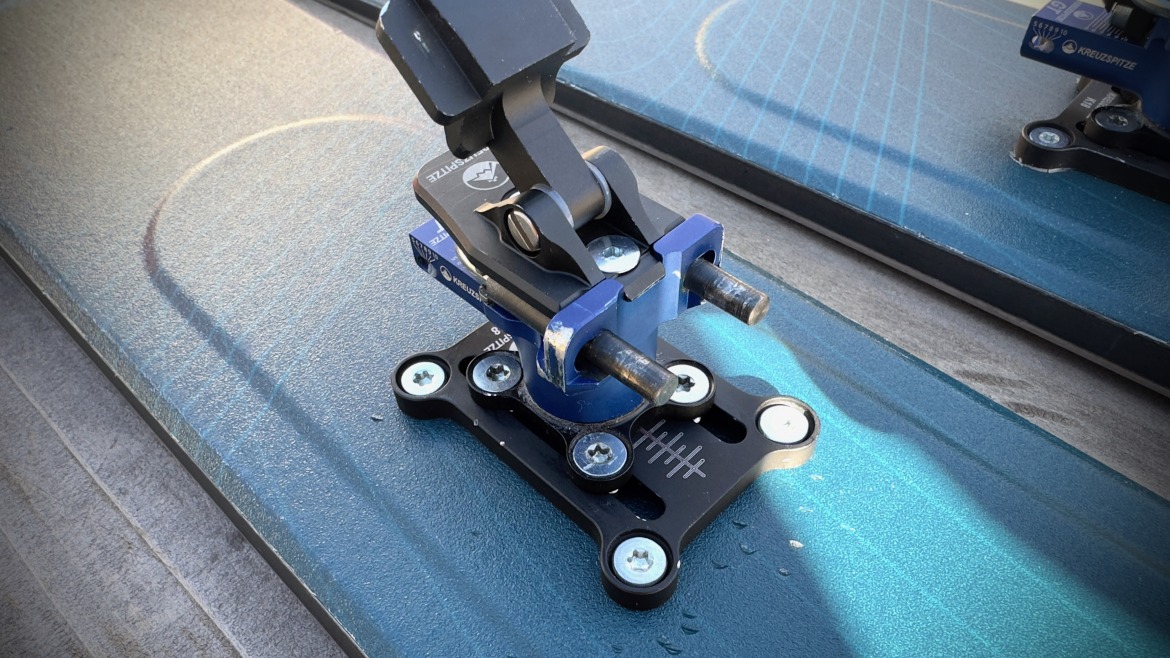
Ensure the heel unit’s gap is adjusted properly to prevent any interference between the tech heel insert and the heel unit. Where the blue is worn off, I had some rubbing between the heel’s tech fitting and the heel unit when rotated into flat mode.
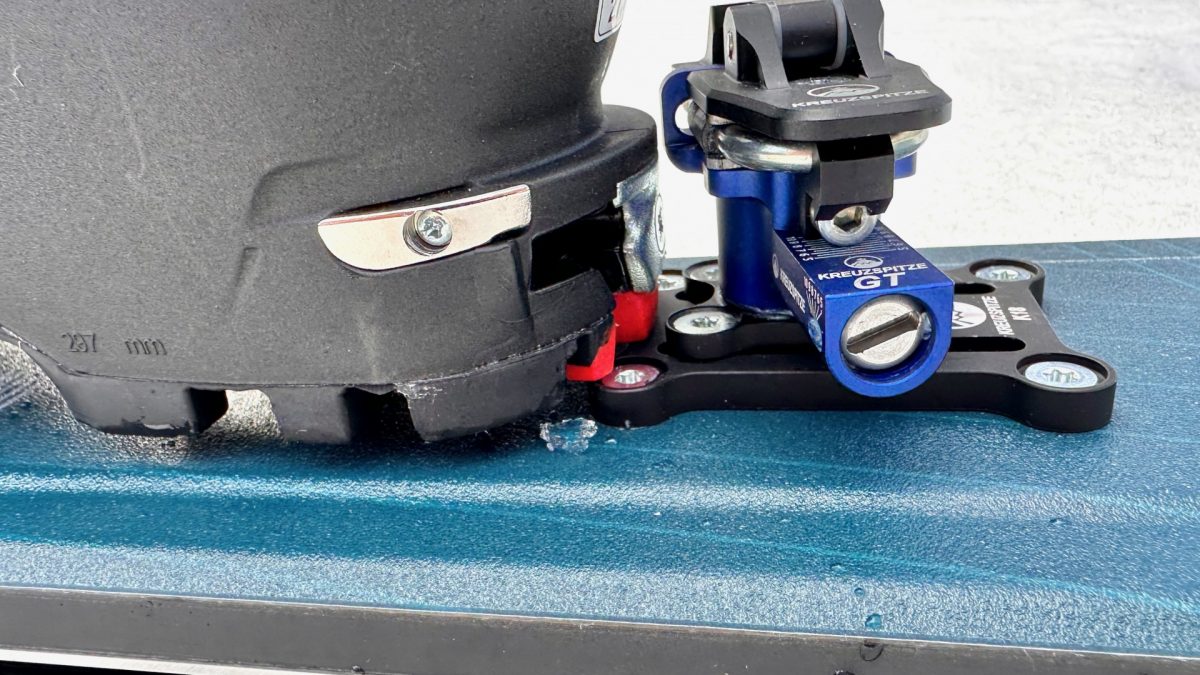
The heel unit turned 90 degrees from pins forward: this is the flat mode. Note the heel unit is positioned at a slight angle, with one side closer to the heel’s tech fitting. In some cases, with the ski flexed, the tech fitting rubbed the heel unit.

The PLUM R170 rotated 90 from pins forward and into flat mode. In this instance, the heel unit is a uniform distance from the boot heel, with less potential for rubbing when skinning.
One comment from the first look caught my attention regarding the heel unit. Here it is: “My 2c is to be quite sure you have set the heel gap correctly with the Kreuzspitze spacer, or your boot’s heel tech fitting will eat metal away from the heel unit as you tour. There is very little tolerance for ski flex as you are skinning.”
The heel gap for the Kreuzspitze GT 2.0 is 6mm. I used the proper spacer and had to nudge the heel unit back a hair to ensure my heel tech fitting did not rub aluminum when in flat mode. You’ll see from the photo that when the heel unit is pivoted to flat, one side is closer to the tech fitting than the other. (Note the difference with a Plum R-170 heel unit: when in flat mode, the heel unit is a single uniform distance from the tech fitting. There’s less potential for rubbing/interference.)
Mostly, I had no rubbing. Except on a semi-humid day in Canada where snow/frost/ice built up on my tech fitting, and the skis flexed on the skintrack, the rubbing ensued. I could, for the most part, mitigate the issue. I adjusted the bindings that night at the hut, and with no heel gap tool on hand, eyeballed maybe .3mm, and problem solved.
Comparisons
As I wrote above, many users live in regions where rotating a heel is an afterthought: some simply don’t do it much by choice, or they live in a zone where long, steady grades are the norm. Frequent insightful commenter, Slim, asked for a comparison with the ATK Haute Route. I’ve owned a set of BD Helio 200s for several years; these were Black Diamond’s rebranded version of the Haute Route. Generally, both bindings are well made. The weights, with adjustment plates, are similar, ~218g for the Kreuzspitze GT 2.0 and ~210 for the Haute Route.
The main difference, at least for me, brings us back to….the heels. In flat mode with the Haute Route’s heel rotated 180 degrees from pins forward, you’ve got access to pure flat and the higher of the two risers. If you live in or frequent a range with set-your-riser-preference-and-ascend terrain, then either binding should work great.
Getting into and out of the toe units is smooth and crisp, as is stomping into the heels. The risers on the Haute Route are magnetic and are just ever so slightly easier to deploy than the risers on the Kreuzspitze GT 2.0.
The Haute Route will cost you ~$600.00 and comes with a 30mm adjustment plate. The Kreuzspitze GT 2.0 costs ~$460.00 but will costs between $45-$57 depending on the adjustment plate option you choose.
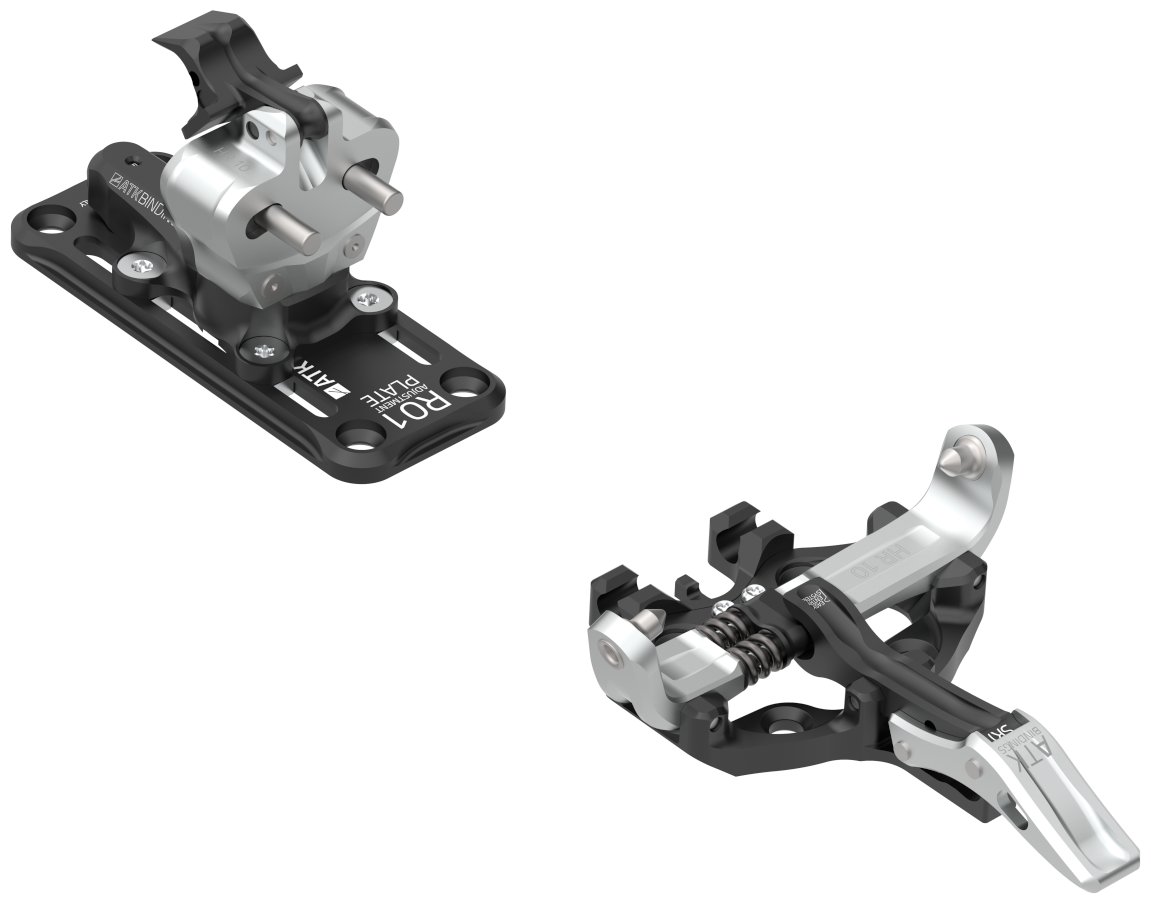
The ATK Haute Route binding offers a ~210g package with adjustable release values. The main difference, for those riser users, is the ability to use flat mode and the high riser without rotating the heel unit. This binding also costs $600.00. Photo: ATK.
Closing it Out
The Kreuzspitze GT 2.0 is recommended if the feature set is to your liking. You do, however, have options. You could go with the Salomon/Atomic Pure and have fixed retention values depending on your chosen U-spring value and access to flat-low-and-high risers with no heel twist. You could opt for something like the Haute Route or the Kreuzspitze GT 2.0 and be well served too. If opting for the Kreuzspitze GT 2.0, nail the heel gap down.
And a minor issue, really, for all binding manufacturers: leashes can be pricey. I like to pay for quality and have no issue supporting companies that support backcountry skiers. My ATK leashes do not work on the Kreuzspitze GT 2.0. Something like $37.00 later, and I had a suitable leash. Anyhow, it all adds up.
In the Kreuzspitze GT 2.0, we see another bright spot in the tech binding segment that is light and solid.
Kreuzspitze GT 2.0 Basic Stats
Weight Heel+Toe Unit: 190g
Weight Heel +Toe Unit+Plate/Screws: 218g
Weight Toe Unit: 92g
Weight Heel Unit: 98g
Weight Plate+Screws: 28g
Lateral Release Value: 5-10
Vertical Release Value: 5-10
Riser Positions: flat, ~37mm, ~52mm
Delta: ~0 degrees with no plate.
Ski Crampon Slot: optional/included
Made In: Italy
Price: MSRP $459.95 (no adjustment plate)
Jason Albert comes to WildSnow from Bend, Oregon. After growing up on the East Coast, he migrated from Montana to Colorado and settled in Oregon. Simple pleasures are quiet and long days touring. His gray hair might stem from his first Grand Traverse in 2000 when rented leather boots and 210cm skis were not the speed weapons he had hoped for. Jason survived the transition from free-heel kool-aid drinker to faster and lighter (think AT), and safer, are better.

